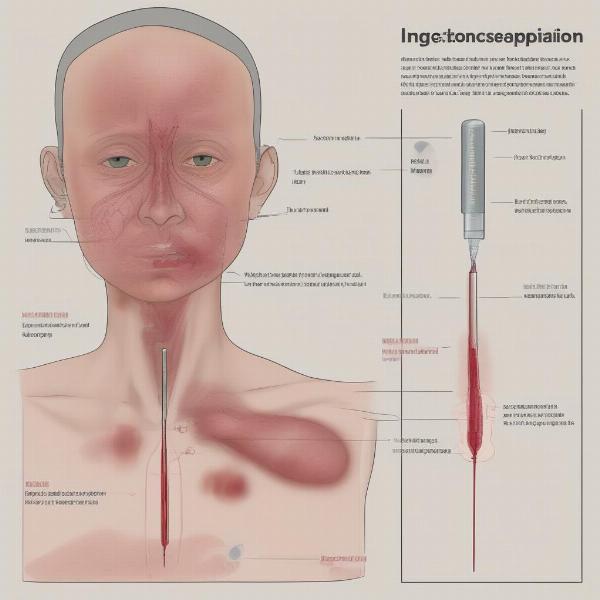Knowing the correct dog injection sites is crucial for administering medications safely and effectively. Whether you’re giving subcutaneous fluids, vaccinations, or other injections, understanding the appropriate locations and techniques can minimize discomfort for your dog and prevent potential complications. This guide provides a detailed overview of common dog injection sites, best practices, and important considerations for pet owners.
Understanding the Importance of Correct Injection Sites
Administering injections in the wrong location can lead to various issues, including pain, nerve damage, abscess formation, and even broken needles. Choosing the right site and using proper technique is essential for ensuring your dog’s safety and the effectiveness of the medication.
Common Dog Injection Sites
There are three primary injection sites commonly used in dogs:
-
Scruff (Subcutaneous): The loose skin on the back of the neck, often referred to as the “scruff,” is the most common site for subcutaneous injections. This area offers ample space and is relatively easy to access. Subcutaneous injections are administered just under the skin, into the fatty tissue layer.
-
Shoulder Blades (Subcutaneous/Intramuscular): The area between the shoulder blades can be used for both subcutaneous and intramuscular injections, depending on the specific medication. Intramuscular injections are administered deeper, into the muscle tissue.
-
Thigh Muscles (Intramuscular): The large muscles of the hind legs, specifically the thigh, are often used for intramuscular injections requiring larger volumes of medication.
Best Practices for Administering Dog Injections
-
Restraint: Proper restraint is crucial to prevent injury to both you and your dog. Have someone assist you in holding your dog securely, or use a towel to gently wrap and restrain them.
-
Needle Preparation: Ensure you use a sterile needle of the appropriate size for the injection and the medication being administered. If you are unsure about the correct needle size, consult your veterinarian.
-
Injection Technique: For subcutaneous injections, tent the skin by gently pinching it upwards. Insert the needle at a 45-degree angle into the tented skin. For intramuscular injections, insert the needle at a 90-degree angle directly into the muscle.
-
Aspiration: Before injecting, aspirate the syringe by gently pulling back on the plunger. If you see blood, withdraw the needle and choose a different injection site. Blood indicates that you have hit a blood vessel.
-
Injection: Slowly inject the medication, then gently withdraw the needle. Apply light pressure to the injection site with a cotton ball to prevent bleeding.
When to Consult a Veterinarian
 Dog Injection Site Complications
Dog Injection Site Complications
While administering injections at home might be necessary in certain situations, it’s always recommended to consult your veterinarian. They can provide guidance on proper injection techniques, recommend the appropriate injection site, and advise on any potential risks or side effects. You should seek immediate veterinary care if you notice any of the following:
- Swelling or redness at the injection site: This could indicate an infection or an allergic reaction.
- Discharge from the injection site: This is another sign of a potential infection.
- Pain or discomfort: If your dog appears to be in pain after the injection, it’s essential to contact your vet.
- Broken needle: If the needle breaks during the injection, do not attempt to remove it yourself. Seek immediate veterinary attention.
Frequently Asked Questions (FAQ)
- Can I give my dog injections myself? While it’s possible, it’s always best to consult a veterinarian first for guidance and training.
- What if my dog yelps during the injection? This could indicate pain or discomfort. Stop the injection and consult your veterinarian.
- How do I dispose of used needles? Place used needles in a sharps container and dispose of them according to local regulations.
- What if I accidentally inject the medication into the wrong location? Contact your veterinarian immediately.
- Can I reuse needles? Never reuse needles. Always use a fresh, sterile needle for each injection.
- How do I know if my dog is having an allergic reaction to the injection? Signs of an allergic reaction include swelling, hives, difficulty breathing, and vomiting. Seek immediate veterinary care if you notice any of these symptoms.
- What if I miss a dose of my dog’s medication? Contact your veterinarian for guidance.
Related Articles on ILM Dog
- subcutaneous injection sites in dogs
- oral ivermectin dosage calculator for dogs pdf
- dog flea shots
- worm treatment for dogs
About ILM Dog
ILM Dog (https://ilmdog.com) is your trusted resource for expert advice on dog care and wellbeing. We offer comprehensive information on various aspects of dog ownership, including breed selection, health and medical care, training and behavior, nutrition, grooming, and product recommendations. Our focus on health and medical care ensures you have access to the best information regarding your dog’s wellbeing, including advice on vaccinations and medication administration. For expert guidance on your dog’s specific needs, contact us via email at [email protected] or call us at +44 20-3965-8624.